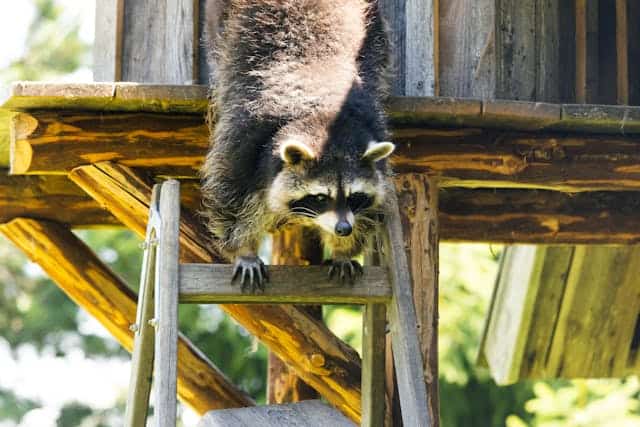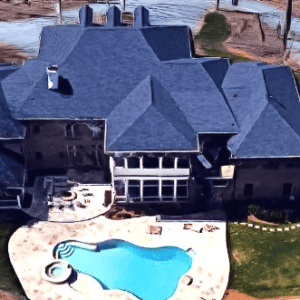Although raccoons have a cute and cuddly appearance, they can be sneaky and even dangerous. It is not a fear for raccoons to approach your house. Because of their infamous scavenging behaviors, raccoons can be an annoyance to homeowners.
Act quickly if you suspect a raccoon infestation is critical to stop additional property damage and possible health risks to you and your family.
Raccoons can be found throughout most of the United States; they often enter cities and suburbs in search of food and shelter. Raccoons may dig up your yard and tip over trash cans, but if they decide to take up residence in your shed, attic, or roof, they can cause major issues.
Securing your garbage cans, eliminating easy-to-nest locations like crawlspaces, and eliminating food sources are some ways to make your property uninviting.
To learn how to recognize and eliminate a raccoon infestation on your property, read this comprehensive guide.
A Short Overview of Raccoons
The actual raccoon is a small mammal with a maximum length of three feet. Although their color is usually gray, they have dark rings on their tails and a characteristic black mask across their eyes.
Their dexterous paws enable them to climb trees, trash cans, siding, and fencing with ease. Their five-fingered, dexterous paws resemble two- or three-inch handprints.
Due to their nocturnal lifestyle and lack of social skills, raccoons can be difficult to locate. Since they are most active in the early morning or late evening, these are the best times to spot them.
Being omnivores, they can survive in nearly any setting that provides them with food and a stable place to live, such as garages, attics, floating decks, and brush piles.
Are Raccoons a Threat?
Raccoons are dangerous animals despite their cuddly round bodies and big eyes giving them an innocent appearance.
Dissimilar to other animals, they can enter trash cans and frequently tip them over, dispersing waste all over your property. Raccoons raise your yard’s risk of parasite infestation and disease spread by covering it with contaminated materials.
They also have a history of carrying rabies, which increases the likelihood that they will approach and bite people and animals.
They have been known to viciously attack adults, children, and pets when they feel threatened, even if they do not have rabies. A raccoon attack will result in dire consequences because of their razor-sharp teeth and claws.
It is evident why it is always a bad idea to purposefully feed them or try to trap them without the assistance of a professional.
Warning Indications of a Raccoon Infestation
- Observable Raccoons: Although seeing a raccoon once in a while is not a cause for alarm, seeing them more often may mean that a raccoon nest is close by.
- Unusual Sounds: Raccoon activity may be indicated by odd noises you hear at night coming from your walls or attic. During their movement and social interactions, raccoons are known to produce loud noises.
- Roof or Attic Damages: Raccoons may have been using your roof as a means of access to your attic if you notice any missing or damaged roof shingles. Once inside, they have the potential to harm surrounding boxes, insulation, and wiring.
- Tipped Over Garbage Cans: In their constant pursuit of food, raccoons frequently topple trash cans. There might be a raccoon problem if you discover that your trash cans have been overturned or searched through.
- Bad Smells and Droppings: Raccoons emit a characteristic musky smell, which is stronger in small areas like attics. Raccoon droppings have a cylindrical shape and can reach lengths of up to three inches.
- Odd Pet behaviors: Your dog or cat may react negatively if raccoons are around. If they notice raccoons nearby, they might growl out of a window or focus on areas of the ceiling beneath a nest.
How to Handle a Raccoon Infestation?
It’s critical to recognize the telltale signs of raccoon activity and take appropriate action to get them out of your house.
Inspection and Prevention
Future raccoon infestations must be avoided. One way to keep raccoons out of your house is to periodically check for entry points and seal them off. Raccoons can also be kept off your property by removing possible food sources and adding motion-activated lights.
Identification of the Entry Points
Raccoons can get into your house through chimneys, vents, and roof crevices. After locating the entry points, you can take action to block them off to stop raccoon activity from occurring.
Elimination of the Alluring Elements
Since raccoons are drawn to food, you can help discourage them by eliminating any possible food sources from around your house. Ensure that your trash cans are locked and out of raccoons’ easy reach. Make sure that any bird feeder you have is out of raccoons’ easy reach. To deter raccoons, you can also place motion-activated lights throughout your property.
Capturing and Removing
It might be essential to trap and remove raccoons from your home if you have discovered an infestation. To ensure the safe and humane capture and removal of raccoons, it is imperative to engage the services of a wildlife removal company. It can be risky to try trapping raccoons on your own as you might hurt the animal as well as yourself.
Cleaning and Restoration
Cleaning up and fixing any damage the raccoons may have caused is crucial after they have been removed from your house. This can entail replacing missing roof shingles, fixing damaged insulation, and cleaning raccoon-inhabited areas.
Raccoons are often harmful and dangerous. If you see indications of a raccoon infestation, employ more effective methods to get rid of them, like hiring a pro exterminator or contacting a wildlife removal service.




